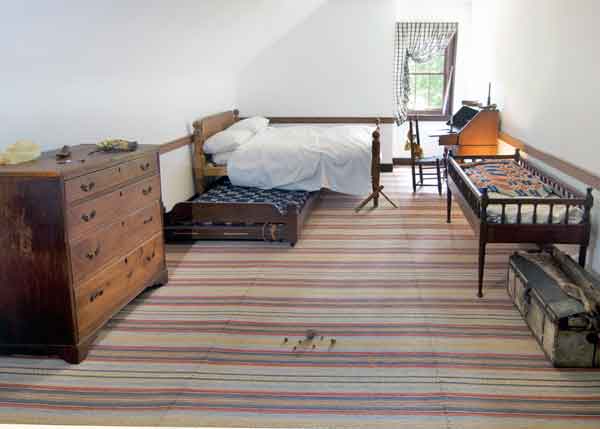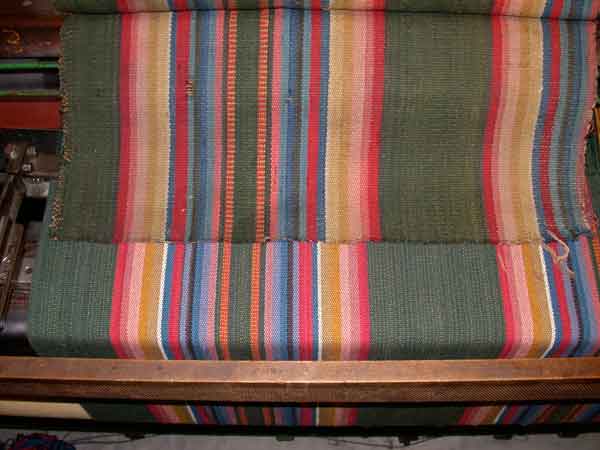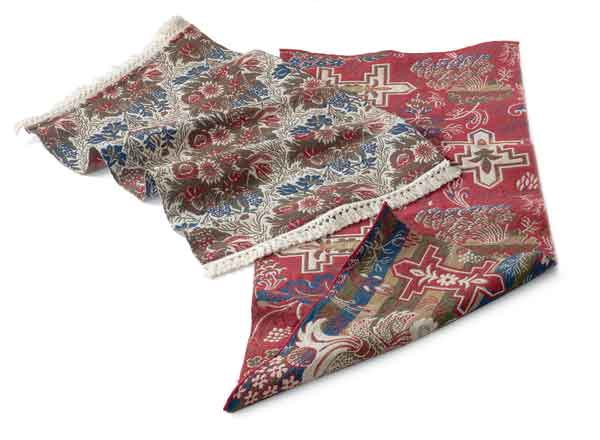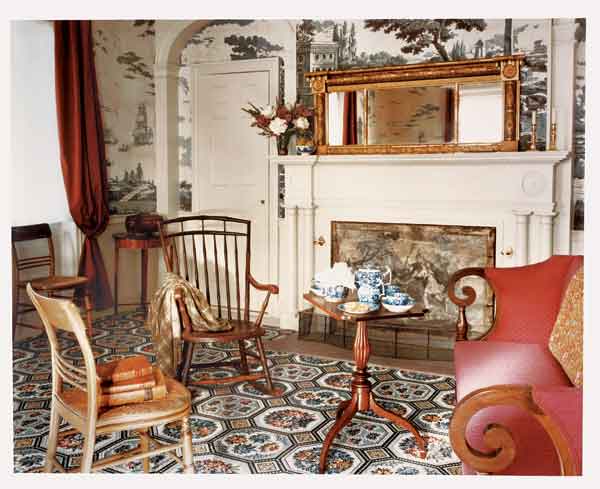A newly reproduced list (rag) rug in the boys’ bedroom at Locust Grove (1792) in Louisville, Kentucky; S and Z twists in the stripes are common design elements. By The Weavery.
The earliest American householders did not put their scarce and costly textiles on the floor. Small English-made “Turkey” carpets covered tables, and loop-pile rugs were used as bed covers.
It wasn’t long, though, until affordable rugs were available, and you will probably choose to cover your floors for color and comfort today. So let’s start with the most affordable grades and move up.
Cost-Effective Carpeting in the 18th Century
First, remember: The oriental carpet placed on a burnished wood floor dates to after 1880 and is a Colonial Revival convention. When carpets were used in the 18th century, they generally covered a room’s floor from wall to wall. Smaller rugs, or loose floor coverings, were in use, too, particularly for secondary rooms and in modest households. Folks wanted wall-to-wall carpet: With no central heating and single-glazed windows, houses were cold, and carpeting helped. Carpet also “warmed up” an interior aesthetically and dampened noise.
An original Venetian striped carpet (on top) with its wool reproduction (still on the loom) for the 1825 Beall-Stibbs House in Wooster, Ohio. By Thistle Hill Weavers.
Reversible Carpets
Most carpets of the 18th and 19th centuries were reversible, flat-woven goods. Most prevalent were rag rugs made of cotton, along with their up-market cousins, warp-faced Venetian carpets of wool. Rag and Venetian floorcoverings typically were woven in a stripe or a plaid, with little or no repeat in the pattern.
The invention of the Jacquard loom in 1801 permitted the automatic creation of repeating pattern by programming the loom with punch cards. (Before that, any change in pattern had to be done painstakingly by hand, with the weaver selecting the pattern and color of the yarns with each pass of the shuttle.)
Venetian Carpets
Venetians were woven in narrow strips between 27″ and 36″ wide; these were (and still are) hand-sewn together and the resulting carpet tacked down around the perimeter of the room. The stripe might be “broken up” with an alternating repeat known as a ladder stitch. Venetians and rag carpets remained popular through the first half of the 19th century, when they were eclipsed by a patterned version of flat-woven carpet termed ingrain.
Affordable Patterns in the 19th Century
Reversible ‘Flower Garden’ ingrain from a house in Cazenovia, New York, along with red ingrain from Waveland in Lexington, Kentucky. By Family HeirLoom Weavers.
Ingrain Carpets
Also referred to as Scotch or Kidderminster carpets, ingrains took full advantage of the small and large pattern options provided by the Jacquard loom, sporting the fashionable colors and patterns of the decade. Designs evolved much the way wallpaper’s did: from classical to Gothic to Rococo and onward. Reversible wool ingrains are suitable for any room in a house, although today they are preferred in bedchambers and other less-trafficked rooms.
Luxury Carpets
The ca. 1810 Brussels carpet ‘Floral Roman Tile’ is a document reproduction at Historic Deerfield in Massachusetts. By J.R. Burrows & Co.
Pile Carpets
The most expensive carpets of this era (and today) are Wilton and Brussels. These are pile carpets: Tufts of wool are pulled up through the warp and weft, and a decorative surface pattern is created by these tufts of different colored yarns.
The Brussels is a loop pile that reminds many of needlepoint, while Wilton is a cut pile with a velvety feel. Wilton cost much more than Brussels, due to the labor-intensive process of cutting and finishing the pile.
Pile carpets were so expensive that even most affluent households placed them only in the best parlors. It was quite exceptional to find Wilton or Brussels carpet throughout the first floor, let alone in the bedchambers. Instead, flat-woven carpets (and eventually, after 1840, machine-made Axminsters) were used in secondary rooms.







